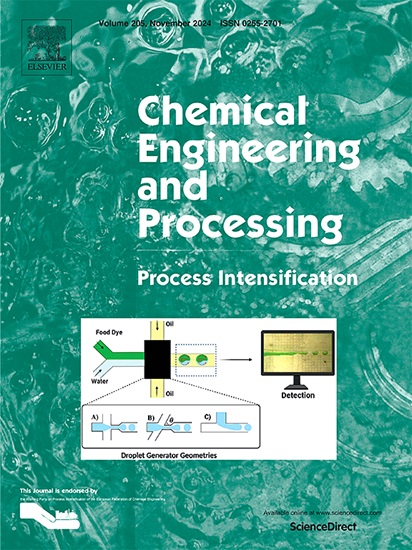A comprehensive review of gas-liquid two-phase flow in static mixers
IF 3.8
3区 工程技术
Q3 ENERGY & FUELS
Chemical Engineering and Processing - Process Intensification
Pub Date : 2025-07-05
DOI:10.1016/j.cep.2025.110434
引用次数: 0
Abstract
In this study, the gas-liquid two-phase flow in the static mixer is comprehensively reviewed from the macroscopic hydrodynamic characteristics to the mesoscopic bubble dynamic behaviors. Firstly, the classification of static mixers and their applications in gas-liquid two-phase flow are summarized. Secondly, the research on energy efficiency and bubble characteristics in the static mixer is outlined. The experimental techniques for measuring the pressure drop (Δp) and identifying bubbles are mainly introduced and the evaluation parameters of flow and mixing characteristics are analyzed, which includes Δp, Sauter mean diameter (d32) and volumetric mass transfer coefficient (kLa). The non-swirling and swirling flow patterns are systematically analyzed and the evolution characteristics of gas-liquid two-phase flow are discussed in horizontal and vertical static mixers. In addition, the multi-scale modeling method of coupling computational fluid dynamics (CFD) and population balance model (PBM) is summarized and the important theories of bubble dynamics are elucidated, which encompass bubble drag, coalescence and breakup models. The applicability and limitations of different models in predicting the bubble size are analyzed. Finally, the flow mechanism of gas-liquid systems in static mixers is systematically summarized and its future prospects are presented.

静态混合器内气液两相流研究综述
本文对静态混合器内气液两相流动从宏观流体动力学特性到细观气泡动力学行为进行了全面的研究。首先,综述了静态混合器的分类及其在气液两相流中的应用。其次,概述了静态混合器的能量效率和气泡特性的研究。主要介绍了压降测量(Δp)和气泡识别的实验技术,分析了流动和混合特性的评价参数Δp、Sauter平均直径(d32)和体积传质系数(kLa)。系统地分析了非旋流和旋流两种流型,讨论了卧式和立式静态混合器中气液两相流的演化特征。总结了计算流体动力学(CFD)与种群平衡模型(PBM)耦合的多尺度建模方法,阐述了气泡动力学的重要理论,包括气泡阻力模型、气泡聚并模型和气泡破裂模型。分析了不同模型在预测气泡大小方面的适用性和局限性。最后,系统总结了静态混合器中气液系统的流动机理,并对其发展前景进行了展望。
本文章由计算机程序翻译,如有差异,请以英文原文为准。
求助全文
约1分钟内获得全文
求助全文
来源期刊
CiteScore
7.80
自引率
9.30%
发文量
408
审稿时长
49 days
期刊介绍:
Chemical Engineering and Processing: Process Intensification is intended for practicing researchers in industry and academia, working in the field of Process Engineering and related to the subject of Process Intensification.Articles published in the Journal demonstrate how novel discoveries, developments and theories in the field of Process Engineering and in particular Process Intensification may be used for analysis and design of innovative equipment and processing methods with substantially improved sustainability, efficiency and environmental performance.

 求助内容:
求助内容: 应助结果提醒方式:
应助结果提醒方式:


